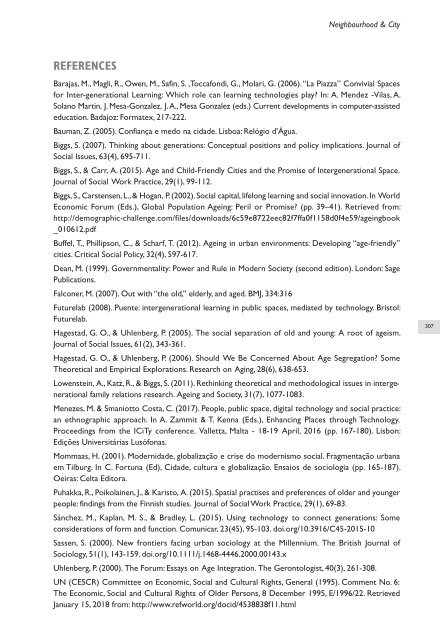Culture&Territories#3
Create successful ePaper yourself
Turn your PDF publications into a flip-book with our unique Google optimized e-Paper software.
Neighbourhood & City<br />
REFERENCES<br />
Barajas, M., Magli, R., Owen, M., Safin, S. ,Toccafondi, G., Molari, G. (2006).“La Piazza” Convivial Spaces<br />
for Inter-generational Learning: Which role can learning technologies play? In: A. Mendez -Vilas, A.<br />
Solano Martin, J. Mesa-Gonzalez, J.A., Mesa Gonzalez (eds.) Current developments in computer-assisted<br />
education. Badajoz: Formatex, 217-222.<br />
Bauman, Z. (2005). Confiança e medo na cidade. Lisboa: Relógio d’Água.<br />
Biggs, S. (2007). Thinking about generations: Conceptual positions and policy implications. Journal of<br />
Social Issues, 63(4), 695-711.<br />
Biggs, S., & Carr, A. (2015). Age and Child-Friendly Cities and the Promise of Intergenerational Space.<br />
Journal of Social Work Practice, 29(1), 99-112.<br />
Biggs, S., Carstensen, L., & Hogan, P. (2002). Social capital, lifelong learning and social innovation. In World<br />
Economic Forum (Eds.), Global Population Ageing: Peril or Promise? (pp. 39–41). Retrieved from:<br />
http://demographic-challenge.com/files/downloads/6c59e8722eec82f7ffa0f1158d0f4e59/ageingbook<br />
_010612.pdf<br />
Buffel, T., Phillipson, C., & Scharf, T. (2012). Ageing in urban environments: Developing “age-friendly”<br />
cities. Critical Social Policy, 32(4), 597-617.<br />
Dean, M. (1999). Governmentality: Power and Rule in Modern Society (second edition). London: Sage<br />
Publications.<br />
Falconer, M. (2007). Out with “the old,” elderly, and aged. BMJ, 334:316<br />
Futurelab (2008). Puente: intergenerational learning in public spaces, mediated by technology. Bristol:<br />
Futurelab.<br />
Hagestad, G. O., & Uhlenberg, P. (2005). The social separation of old and young: A root of ageism.<br />
Journal of Social Issues, 61(2), 343-361.<br />
Hagestad, G. O., & Uhlenberg, P. (2006). Should We Be Concerned About Age Segregation? Some<br />
Theoretical and Empirical Explorations. Research on Aging, 28(6), 638-653.<br />
Lowenstein, A., Katz, R., & Biggs, S. (2011). Rethinking theoretical and methodological issues in intergenerational<br />
family relations research. Ageing and Society, 31(7), 1077-1083.<br />
Menezes, M. & Smaniotto Costa, C. (2017). People, public space, digital technology and social practice:<br />
an ethnographic approach. In A. Zammit & T. Kenna (Eds.), Enhancing Places through Technology.<br />
Proceedings from the ICiTy conference. Valletta, Malta - 18-19 April, 2016 (pp. 167-180). Lisbon:<br />
Edições Universitárias Lusófonas.<br />
Mommaas, H. (2001). Modernidade, globalização e crise do modernismo social. Fragmentação urbana<br />
em Tilburg. In C. Fortuna (Ed), Cidade, cultura e globalização. Ensaios de sociologia (pp. 165-187).<br />
Oeiras: Celta Editora.<br />
Puhakka, R., Poikolainen, J., & Karisto, A. (2015). Spatial practises and preferences of older and younger<br />
people: findings from the Finnish studies. Journal of Social Work Practice, 29(1), 69-83.<br />
Sánchez, M., Kaplan, M. S., & Bradley, L. (2015). Using technology to connect generations: Some<br />
considerations of form and function. Comunicar, 23(45), 95-103. doi.org/10.3916/C45-2015-10<br />
Sassen, S. (2000). New frontiers facing urban sociology at the Millennium. The British Journal of<br />
Sociology, 51(1), 143-159. doi.org/10.1111/j.1468-4446.2000.00143.x<br />
Uhlenberg, P. (2000). The Forum: Essays on Age Integration. The Gerontologist, 40(3), 261-308.<br />
UN (CESCR) Committee on Economic, Social and Cultural Rights, General (1995). Comment No. 6:<br />
The Economic, Social and Cultural Rights of Older Persons, 8 December 1995, E/1996/22. Retrieved<br />
January 15, 2018 from: http://www.refworld.org/docid/4538838f11.html<br />
307



